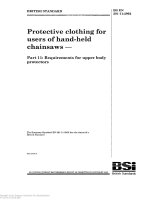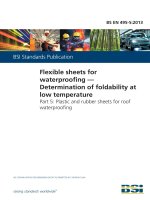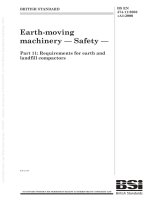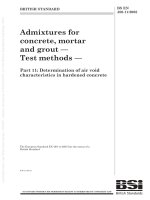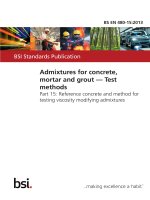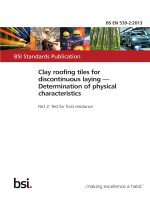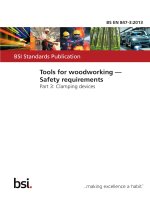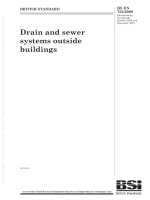Bsi bs en 61400 11 2013
Bạn đang xem bản rút gọn của tài liệu. Xem và tải ngay bản đầy đủ của tài liệu tại đây (2.42 MB, 62 trang )
BS EN 61400-11:2013
BSI Standards Publication
Wind turbines
Part 11: Acoustic noise
measurement techniques
NO COPYING WITHOUT BSI PERMISSION EXCEPT AS PERMITTED BY COPYRIGHT LAW
raising standards worldwide™
BRITISH STANDARD
BS EN 61400-11:2013
National foreword
This British Standard is the UK implementation of EN 61400-11:2013.
It is identical to IEC 61400-11:2012. It supersedes BS EN 61400-11:2003,
which is withdrawn.
The UK participation in its preparation was entrusted to Technical Committee
PEL/88, Wind turbines.
A list of organizations represented on this committee can be obtained on
request to its secretary.
This publication does not purport to include all the necessary provisions of a
contract. Users are responsible for its correct application.
© The British Standards Institution 2013.
Published by BSI Standards Limited 2013.
ISBN 978 0 580 68190 5
ICS 27.180
Compliance with a British Standard cannot confer immunity
from legal obligations.
This British Standard was published under the authority of the
Standards Policy and Strategy Committee on 30 April 2013.
Amendments issued since publication
Date
Text affected
BS EN 61400-11:2013
EUROPEAN STANDARD
EN 61400-11
NORME EUROPÉENNE
EUROPÄISCHE NORM
March 2013
ICS 27.180
Supersedes EN 61400-11:2003 + A1:2006
English version
Wind turbines Part 11: Acoustic noise measurement techniques
(IEC 61400-11:2012)
Eoliennes Partie 11: Techniques de mesure
du bruit acoustique
(CEI 61400-11:2012)
Windenergieanlagen Teil 11: Schallmessverfahren
(IEC 61400-11:2012)
This European Standard was approved by CENELEC on 2012-12-12. CENELEC members are bound to comply
with the CEN/CENELEC Internal Regulations which stipulate the conditions for giving this European Standard
the status of a national standard without any alteration.
Up-to-date lists and bibliographical references concerning such national standards may be obtained on
application to the CEN-CENELEC Management Centre or to any CENELEC member.
This European Standard exists in three official versions (English, French, German). A version in any other
language made by translation under the responsibility of a CENELEC member into its own language and notified
to the CEN-CENELEC Management Centre has the same status as the official versions.
CENELEC members are the national electrotechnical committees of Austria, Belgium, Bulgaria, Croatia, Cyprus,
the Czech Republic, Denmark, Estonia, Finland, Former Yugoslav Republic of Macedonia, France, Germany,
Greece, Hungary, Iceland, Ireland, Italy, Latvia, Lithuania, Luxembourg, Malta, the Netherlands, Norway, Poland,
Portugal, Romania, Slovakia, Slovenia, Spain, Sweden, Switzerland, Turkey and the United Kingdom.
CENELEC
European Committee for Electrotechnical Standardization
Comité Européen de Normalisation Electrotechnique
Europäisches Komitee für Elektrotechnische Normung
Management Centre: Avenue Marnix 17, B - 1000 Brussels
© 2013 CENELEC -
All rights of exploitation in any form and by any means reserved worldwide for CENELEC members.
Ref. No. EN 61400-11:2013 E
BS EN 61400-11:2013
EN 61400-11:2013
Foreword
The text of document 88/436/FDIS, future edition 3 of IEC 61400-11, prepared by IEC/TC 88 "Wind
Turbines" was submitted to the IEC-CENELEC parallel vote and approved by CENELEC as
EN 61400-11:2013.
The following dates are fixed:
•
latest date by which the document has
to be implemented at national level by
publication of an identical national
standard or by endorsement
(dop)
2013-09-12
•
latest date by which the national
standards conflicting with the
document have to be withdrawn
(dow)
2015-12-12
This document supersedes EN 61400-11:2003 + A1:2006.
EN 61400-11:2013 includes the
EN 61400-11:2003 + A1:2006:
following
significant
technical
changes
with
respect
to
The technical change is introducing new principles for data reduction procedures.
Attention is drawn to the possibility that some of the elements of this document may be the subject of
patent rights. CENELEC [and/or CEN] shall not be held responsible for identifying any or all such
patent rights.
Endorsement notice
The text of the International Standard IEC 61400-11:2012 was approved by CENELEC as a European
Standard without any modification.
BS EN 61400-11:2013
EN 61400-11:2013
Annex ZA
(normative)
Normative references to international publications
with their corresponding European publications
The following documents, in whole or in part, are normatively referenced in this document and are
indispensable for its application. For dated references, only the edition cited applies. For undated
references, the latest edition of the referenced document (including any amendments) applies.
NOTE When an international publication has been modified by common modifications, indicated by (mod), the relevant EN/HD
applies.
Publication
Year
Title
IEC 60688
-
Electrical measuring transducers for
EN 60688
converting A.C. and D.C. ectrical quantities
to analogue or digital signals
-
IEC 60942
2003
Electroacoustics - Sound calibrators
EN 60942
2003
IEC 61260
1995
Electroacoustics - Octave-band and
fractional-octave-band filters
EN 61260
1995
IEC 61400-12-1
2005
Wind turbines Part 12-1: Power performance
measurements of electricity producing
wind turbines
EN 61400-12-1
2006
IEC 61400-12-2
-
Wind turbines Part 12-2: Power performance of electricity
producing wind turbines based on nacelle
anemometry
EN 61400-12-2
-
IEC 61672
Series Electroacoustics - Sound level meters
EN 61672
Series
-
-
ISO/IEC Guide 98-3 -
1)
To be published.
1)
Uncertainty of measurement Part 3: Guide to the expression of
uncertainty in measurement (GUM:1995)
EN/HD
Year
BS EN 61400-11:2013
61400-11 © IEC:2012(E)
CONTENTS
INTRODUCTION . .................................................................................................................................. 7
1
Scope . ............................................................................................................................................. 8
2
Normative references . .................................................................................................................. 8
3
Terms and definitions . .................................................................................................................. 9
4
Symbols and units ....................................................................................................................... 12
5
Outline of method ........................................................................................................................ 13
6
Instrumentation . .......................................................................................................................... 14
6.1
Acoustic instruments . ....................................................................................................... 14
6.1.1
6.1.2
6.1.3
7
General . ................................................................................................................ 14
Equipment for the determination of the equivalent continuous Aweighted sound pressure level........................................................................... 14
Equipment for the determination of A-weighted 1/3-octave band
spectra . ................................................................................................................. 14
6.1.4 Equipment for the determination of narrow band spectra .............................. 14
6.1.5 Microphone with measurement board and windscreen . ................................. 14
6.1.6 Acoustical calibrator ............................................................................................ 16
6.1.7 Data recording/playback systems . .................................................................... 16
6.2 Non-acoustic Instruments . ............................................................................................... 16
6.2.1 General . ................................................................................................................ 16
6.2.2 Anemometers . ...................................................................................................... 16
6.2.3 Electric power transducer ................................................................................... 17
6.2.4 Other instrumentation . ........................................................................................ 17
6.3 Traceable calibration . ....................................................................................................... 17
Acoustic measurements and measurement procedures . ...................................................... 17
7.1
7.2
8
9
Acoustic measurement positions .................................................................................... 17
Acoustic measurements . ................................................................................................. 20
7.2.1 General . ................................................................................................................ 20
7.2.2 Acoustic measurement requirements . .............................................................. 20
7.2.3 A-weighted sound pressure level . ..................................................................... 21
7.2.4 A-weighted 1/3-octave band measurements . ................................................... 21
7.2.5 A-weighted narrow band measurements . ......................................................... 21
7.2.6 Optional acoustic measurements at positions 2, 3 and 4 ............................... 21
7.2.7 Other optional measurements . ........................................................................... 21
Non-acoustic measurements ..................................................................................................... 21
8.1
8.2
General . ............................................................................................................................. 21
Wind speed measurements ............................................................................................. 22
8.2.1 Determination of the wind speed during wind turbine operation. .................. 22
8.2.2 Wind speed measurements during background noise measurements . ........ 23
8.3
8.4
8.5
Data
Downwind direction . ......................................................................................................... 24
Other atmospheric conditions . ........................................................................................ 24
Rotor speed and pitch angle measurement . .................................................................. 24
reduction procedures. ........................................................................................................ 24
9.1
9.2
General methodology for sound power levels and 1/3-octave band levels . .............. 24
Calculation of sound pressure levels . ............................................................................ 27
BS EN 61400-11:2013
61400-11 © IEC:2012(E)
9.2.1
General . ................................................................................................................ 27
9.2.2 Calculation of average sound spectra and uncertainty per bin ..................... 27
9.2.3 Calculation of average wind speed and uncertainty per bin . ......................... 29
9.2.4 Calculation of noise levels at bin centres including uncertainty . .................. 30
9.3 Apparent sound power levels . ......................................................................................... 31
9.4 Apparent sound power levels with reference to wind speed in 10 m height ............. 32
9.5 Tonal audibility . ................................................................................................................. 33
9.5.1 General methodology for tonality . ..................................................................... 33
9.5.2 Identifying possible tones ................................................................................... 34
9.5.3 Classification of spectral lines within the critical band . .................................. 34
9.5.4 Identified tone ...................................................................................................... 37
9.5.5 Determination of the tone level .......................................................................... 37
9.5.6 Determination of the masking noise level ......................................................... 37
9.5.7 Determination of tonality . .................................................................................... 37
9.5.8 Determination of audibility . ................................................................................ 38
9.5.9 Background noise . ............................................................................................... 38
10 Information to be reported . ........................................................................................................ 39
10.1 General . ............................................................................................................................. 39
10.2 Characterisation of the wind turbine . ............................................................................. 39
10.3 Physical environment . ...................................................................................................... 39
10.4 Instrumentation . ................................................................................................................ 40
10.5 Acoustic data . ................................................................................................................... 40
10.6 Non-acoustic data ............................................................................................................. 41
10.7 Uncertainty . ........................................................................................................................ 41
Annex A (informative) Other possible characteristics of wind turbine noise emission
and their quantification . .................................................................................................................... 42
Annex B (informative) Assessment of turbulence intensity ......................................................... 44
Annex C (informative) Assessment of measurement uncertainty . ............................................. 45
Annex D (informative) Apparent roughness length . ..................................................................... 47
Annex E (informative) Characterization of a secondary wind screen. ........................................ 49
Annex F (normative) Small wind turbines . ..................................................................................... 53
Annex G (informative) Air absorption ............................................................................................. 57
Bibliography ......................................................................................................................................... 58
Figure 1 – Mounting of the microphone . ......................................................................................... 15
Figure 2 – Picture of microphone and measurement board . ......................................................... 16
Figure 3 – Standard pattern for microphone measurement positions (plan view) ..................... 18
Figure 4 – Illustration of the definitions of R 0 and slant distance R 1 . ......................................... 19
Figure 5 – Acceptable meteorological mast position (hatched area) . ......................................... 22
Figure 6 – Flowchart showing the data reduction procedure . ...................................................... 26
Figure 7 – Flowchart for determining tonal audibility for each wind speed bin . ........................ 33
Figure 8 – Illustration of L 70 % level in the critical band . ............................................................. 35
Figure 9 – Illustration of lines below the L 70 % + 6 dB criterion . ................................................ 36
Figure 10 – Illustration of L pn,avg level and lines classified as masking. .................................. 36
Figure 11 – Illustration of classifying all spectral lines .................................................................. 37
Figure E.1 – Example 1 of a secondary wind screen . ................................................................... 50
BS EN 61400-11:2013
61400-11 © IEC:2012(E)
Figure E.2 – Example 2 of secondary wind screen . ...................................................................... 51
Figure E.3 – Example on insertion loss from Table E.1 . .............................................................. 52
Figure F.1 – Allowable region for meteorological mast position as a function of β –
Plan view . ............................................................................................................................................ 54
Figure F.2 – Example immission noise map ................................................................................... 56
Figure G.1 – Example of 1/3-octave spectrum . .............................................................................. 57
Table C.1 – Examples of possible values of type B uncertainty components relevant
for apparent sound power spectra . .................................................................................................. 46
Table C.2 – Examples of possible values of type B uncertainty components for wind
speed determination relevant for apparent sound power spectra ................................................ 46
Table D.1 – Roughness length . ........................................................................................................ 47
Table E.1 – Example on reporting of insertion loss. ...................................................................... 51
BS EN 61400-11:2013
61400-11 © IEC:2012(E)
–7–
INTRODUCTION
The purpose of this part of IEC 61400 is to provide a uniform methodology that will ensure
consistency and accuracy in the measurement and analysis of acoustical emissions by wind
turbine generator systems. This International Standard has been prepared with the
anticipation that it would be applied by:
•
wind turbine manufacturers striving to meet well defined acoustic emission performance
requirements and/or a possible declaration system (e.g. IEC/TS 61400-14);
•
wind turbine purchasers for specifying performance requirements;
•
wind turbine operators who may be required to verify that stated, or required, acoustic
performance specifications are met for new or refurbished units;
•
wind turbine planners or regulators who must be able to accurately and fairly define
acoustical emission characteristics of a wind turbine in response to environmental
regulations or permit requirements for new or modified installations.
This standard provides guidance in the measurement, analysis and reporting of complex
acoustic emissions from wind turbine generator systems. The standard will benefit those
parties involved in the manufacture, installation, planning and permitting, operation,
utilization, and regulation of wind turbines. The measurement and analysis techniques
recommended in this document should be applied by all parties to ensure that continuing
development and operation of wind turbines is carried out in an atmosphere of consistent and
accurate communication relative to environmental concerns. This standard presents
measurement and reporting procedures expected to provide accurate results that can be
replicated by others.
–8–
BS EN 61400-11:2013
61400-11 © IEC:2012(E)
WIND TURBINES –
Part 11: Acoustic noise measurement techniques
1
Scope
This part of IEC 61400 presents measurement procedures that enable noise emissions of a
wind turbine to be characterised. This involves using measurement methods appropriate to
noise emission assessment at locations close to the machine, in order to avoid errors due to
sound propagation, but far away enough to allow for the finite source size. The procedures
described are different in some respects from those that would be adopted for noise
assessment in community noise studies. They are intended to facilitate characterisation of
wind turbine noise with respect to a range of wind speeds and directions. Standardisation of
measurement procedures will also facilitate comparisons between different wind turbines.
The procedures present methodologies that will enable the noise emissions of a single wind
turbine to be characterised in a consistent and accurate manner. These procedures include
the following:
•
location of acoustic measurement positions;
•
requirements for the acquisition of acoustic, meteorological, and associated wind turbine
operational data;
•
analysis of the data obtained and the content for the data report; and
•
definition of specific acoustic emission parameters, and associated descriptors which are
used for making environmental assessments.
This International Standard is not restricted to wind turbines of a particular size or type. The
procedures described in this standard allow for the thorough description of the noise emission
from a wind turbine. A method for small wind turbines is described in Annex F.
2
Normative references
The following documents, in whole or in part, are normatively referenced in this document and
are indispensable for its application. For dated references, only the edition cited applies. For
undated references, the latest edition of the referenced document (including any
amendments) applies.
IEC 60688, Electrical measuring transducers for converting a.c. electrical quantities to
analogue or digital signals
IEC 60942:2003, Electroacoustics – Sound calibrators
IEC 61260:1995, Electroacoustics – Octave-band and fractional-octave-band filters
IEC 61400-12-1:2005, Wind turbines – Part 12-1: Power performance measurements of
electricity producing wind turbines
IEC 61400-12-2, Wind turbines – Part 12-2: Power performance verification of electricity
producing wind turbines 1
____________
1
To be published.
BS EN 61400-11:2013
61400-11 © IEC:2012(E)
–9–
IEC 61672 (all parts), Electroacoustics – Sound level meters
ISO/IEC Guide 98-3, Uncertainty of measurement – Part 3: Guide to the expression of
uncertainty in measurement (GUM:1995)
3 Terms and definitions
For the purposes of this standard, the following terms and definitions apply.
3.1
apparent sound power level
L WA
A-weighted sound power level re. 1 pW of a point source at the rotor centre with the same
emission in the downwind direction as the wind turbine being measured, L WA is determined at
bin centre wind speeds at hub height
Note 1 to entry:
Apparent sound power level is expressed in dB re. 1 pW.
3.2
apparent sound power level with reference to wind speed at 10 m height
L WA,10m
A-weighted sound power level re. 1 pW of a point source at the rotor centre with the same
emission in the downwind direction as the wind turbine being measured, LWA,10m are
determined at bin centre wind speeds at 10 m height within the measured wind speed range
Note 1 to entry:
1 pW.
Apparent sound power level with reference to wind speed at 10 m height is expressed in dB re.
3.3
audibility criterion
La
frequency dependent criterion curve determined from listening tests, and reflecting the
subjective response of a “typical” listener to tones of different frequencies
Note 1 to entry:
Audibility criterion is expressed in dB re. 20 µPa.
3.4 sound pressure levels
3.4.1 A-weighted sound pressure levels
LA
sound pressure levels measured with the A frequency weighting networks specified in
IEC 61672
Note 1 to entry:
A-weighted sound pressure levels are expressed in dB re. 20 µPa.
3.4.2 C-weighted sound pressure levels
LC
sound pressure levels measured with the C frequency weighting networks specified in
IEC 61672
Note 1 to entry:
C-weighted sound pressure levels are expressed in dB re. 20 µPa.
3.5
bin centre
centre value of a wind speed bin
– 10 –
BS EN 61400-11:2013
61400-11 © IEC:2012(E)
3.6
inc li nat ion ang le
φ
angle between the plane of the measurement board and a line from the microphone to the
rotor centre
Note 1 to entry:
Inclination angle is expressed in °.
3.7
maximum power
maximum value of the binned power curve for the power optimised mode of operation
Note 1 to entry:
Maximum power is expressed in kW.
3.8
me as u r ed w in d sp e e d a t h ei g h t Z
V Z,m
wind speed measured at height Z with a mast mounted anemometer
Note 1 to entry:
Measured wind speed at height Z is expressed in m/s.
3.9
me as u r ed n a ce ll e w i n d sp ee d at h u b h e ig h t
V nac,m
wind speed measured at hub height with a nacelle anemometer
Note 1 to entry:
Measured n a c e l l e wi n d s p e e d a t h u b h e i g h t is expressed in m/s.
3.10
n o r ma li s ed n a c el le w in d sp e ed at h u b h ei g h t
V nac,n
normalised wind speed measured at hub height with a nacelle anemometer corrected to
standard meteorological conditions
Note 1 to entry:
Normalised nacelle wind speed at hub height is expressed in m/s.
3.11
n o r ma li s ed w in d sp e ed d e r iv ed f ro m p o w er cu rv e
V P,n
normalised wind speed derived from power curve under standard meteorological conditions
Note 1 to entry:
Normalised wind speed derived from power curve is expressed in m/s.
3.12
n o r ma li s ed w in d sp e ed at h u b h ei g h t d u ri n g b a ck g r o u n d no is e m ea su r em ent s
V B,n
normalised wind speed at hub height from anemometer
Note 1 to entry:
m/s.
Normalised wind speed at hub height during background noise measurements is expressed in
3.13
n o r ma li s ed w in d sp e ed at h u b h ei g h t
V H,n
normalised wind speed at hub height
Note 1 to entry:
Normalised wind speed at hub height is expressed in m/s.
3.14
n o r ma li s ed w in d sp e ed at h eig h t Z
V Z,n
normalised wind speed at height Z from mast mounted anemometer
BS EN 61400-11:2013
61400-11 © IEC:2012(E)
Note 1 to entry:
– 11 –
Normalised wind speed at height Z is expressed in m/s.
3.15
reference distance
R0
nominal horizontal distance from the centre of the base of the wind turbine to each of the
prescribed microphone positions
Note 1 to entry:
Reference distance is expressed in m.
3.16
reference roughness length
z 0ref
roughness length of 0,05 m used for converting wind speed to meteorological reference
conditions
Note 1 to entry:
Reference roughness length is expressed in m.
3.17
sound pressure level
Lp
10 times the log 10 of the ratio of the square mean sound pressure to the square of the
reference sound pressure of 20 µPa
Note 1 to entry:
Sound pressure level is expressed in dB re. 20 µPa.
3.18
tonal audibility
∆L a,k
difference between the tonality and the audibility criterion in each wind speed bin, where k is
the centre value of the wind speed bin
Note 1 to entry:
Tonal audibility is expressed in dB.
3.19
tonality
ΔL k
difference between the tone level and the level of the masking noise in the critical band
around the tone in each wind speed bin where k is the centre value of the wind speed bin
Note 1 to entry:
Tonality is expressed in dB.
3.20
wind speed bin
wind speed interval, 0,5 m/s wide, centred around integer and half-integer wind speeds open
at the low end, and closed at the high end
3.21
w ind s pe ed at 10 m h eig h t
V 10
wind speed at 10 m height for reporting apparent sound power levels and spectra with
reference to 10 m height
Note 1 to entry:
Wind speed at 10 m height is expressed in m/s.
– 12 –
4
BS EN 61400-11:2013
61400-11 © IEC:2012(E)
Symbols and units
D
rotor diameter (horizontal axis turbine) or equatorial diameter
(vertical axis turbine)
(m)
H
height of rotor centre (horizontal axis turbine) or height of rotor
equatorial plane (vertical axis turbine) above local ground near
the wind turbine
(m)
L A or L C
A or C-weighted sound pressure level
(dB)
L Aeq
equivalent continuous A-weighted sound pressure level
(dB)
L pn,j,k
sound pressure level of masking noise within a critical band in the
“j th ” spectra at the “k th ” wind speed bin
(dB)
L pn,avg,j,k
average of analysis bandwidth sound pressure levels of masking
noise in the “j th ” spectra at the “k th ” wind speed bin
(dB)
L pt,j,k
sound pressure level of the tone or tones in the “j th ” spectra at the
“k th ” wind speed bin
(dB)
LWA,k
apparent sound power level, where k is a wind speed bin centre
value
(dB)
log
logarithm to base 10
Pm
measured electric power
(kW)
Pn
normalised electric power
(kW)
R1
slant distance, from rotor centre to actual measurement position
(m)
R0
reference distance
(m)
S0
reference area, S 0 = 1 m 2
(m 2 )
TC
air temperature
(°C)
TK
absolute air temperature
(K)
UA
type A uncertainty
(-)
UB
type B uncertainty
(-)
VH
wind speed at hub height, H
(m/s)
VP
derived wind speed from power curve
(m/s)
Vz
wind speed at height, z
(m/s)
V nac
wind speed from nacelle anemometer
(m/s)
f
frequency of the tone
(Hz)
fc
centre frequency of critical band
(Hz)
p
atmospheric pressure
(kPa)
z0
roughness length
(m)
z 0ref
reference roughness length, 0,05 m
(m)
BS EN 61400-11:2013
61400-11 © IEC:2012(E)
– 13 –
z
anemometer height
(m)
κ
ratio of normalised wind speed and measured wind speed
(-)
∆ L tn,j,k
tonality of the “j th ” spectra at “k th ” wind speed
(dB)
φ
inclination angle
(°)
5
Outline of method
This part of IEC 61400 defines the procedures to be used in the measurement, analysis and
reporting of acoustic emissions of a wind turbine. Instrumentation and calibration
requirements are specified to ensure accuracy and consistency of acoustic and non-acoustic
measurements. Non-acoustic measurements required defining the atmospheric conditions
relevant to determining the acoustic emissions are also specified. All parameters to be
measured and reported are identified, as are the data reduction methods required for
obtaining these parameters.
Application of the method described in this International Standard provides the apparent
A-weighted sound power levels, spectra, and tonal audibility at bin centre wind speeds at hub
height and 10 m height of an individual wind turbine. The tonal audibility is included to give
information on the presence of tones in the noise. The tonality determined is not giving
information on the tonality at other distances. Optionally, measurements can be made in
supplementary positions to give information on the directional characteristics.
The method applies to all wind speeds. The wind speed range for documentation is related to
the specific wind turbine. As a minimum it is defined as the hub height wind speed from 0,8 to
1,3 times the wind speed at 85 % of maximum power rounded to bin centres. Indicatively, this
is a wind speed range of approximately 6 to 10 m/s at 10 m height, depending on the turbine
type. The wind speed range may be expanded for instance to comply with national
requirements.
The measurements are made at locations close to the turbine in order to minimise the
influence of terrain effects, atmospheric conditions or wind-induced noise. To account for the
size of the wind turbine under test, a reference distance R 0 based on the wind turbine
dimensions is used.
Measurements are taken with a microphone positioned on a measurement board placed on
the ground to reduce the wind noise generated at the microphone and to minimise the
influence of different ground types.
Measurements of sound pressure levels, sound pressure spectra, wind speeds, electrical
power, rotor rotational speed and, if measured, pitch angle are made simultaneously over
short periods of time and over a wide range of hub height wind speeds. The sound pressure
levels and spectra at bin centre wind speeds are determined and used for calculating the
apparent A-weighted sound power spectra and levels.
Annexes are included that cover:
–
other possible characteristics of wind turbine noise emission and their quantification
(Annex A informative);
–
assessment of turbulence intensity (Annex B informative);
–
assessment of measurement uncertainty (Annex C informative);
–
apparent roughness length (Annex D informative);
–
classification of a secondary wind screen (Annex E informative);
–
small wind turbines (Annex F normative);
BS EN 61400-11:2013
61400-11 © IEC:2012(E)
– 14 –
–
air absorption (Annex G informative).
6
Instrumentation
6.1
6.1.1
Acoustic instruments
General
The following equipment is necessary to perform the acoustic measurements as set forth in
this standard.
6.1.2
Equipment for the determination of the equivalent continuous A-weighted
sound pressure level
The equipment shall meet the requirements of an IEC 61672 class 1 sound level meter.
The diameter of the microphone diaphragm shall be no greater than 13 mm.
6.1.3
Equipment for the determination of A-weighted 1/3-octave band spectra
In addition to the requirements given for class 1 sound level meters, the equipment shall have
a constant frequency response over at least the frequency range given by the 1/3-octave
bands with centre frequencies from 20 Hz to 10 kHz. The filters shall meet the requirements
of IEC 61260 for class 1 filters.
The equivalent A-weighted continuous sound pressure levels in 1/3-octave bands with centre
frequencies from 20 Hz to 10 kHz shall be determined simultaneously.
6.1.4
Equipment for the determination of narrow band spectra
The equipment shall fulfil the relevant requirements
instrumentation in the 20 Hz to 11 200 Hz frequency range.
6.1.5
for
IEC 61672
series
class 1
Microphone with measurement board and windscreen
The microphone shall be mounted at the centre of a flat hard board with the diaphragm of the
microphone in a plane normal to the board and with the axis of the microphone pointing
towards the wind turbine, as in Figure 1 and Figure 2. The measurement board shall be
circular with a diameter of at least 1,0 m and made from material that is acoustically hard,
such as plywood or hard chip-board with a thickness of at least 12,0 mm or metal with a
thickness of at least 2,5 mm. In the exceptional case that the board is split (i.e. not in one
piece) there are considerations; the pieces shall be level within the same plane, the gap less
than 1 mm, and the split shall be off the centre line and parallel with the microphone axis as
shown in Figure 1a.
The windscreen to be used with the ground-mounted microphone shall consist of a primary
and, where necessary, a secondary windscreen. The primary windscreen shall consist of one
half of an open cell foam sphere with a diameter of approximately 90 mm, which is centred
around the diaphragm of the microphone, as in Figure 2.
The secondary windscreen may be used when it is necessary to obtain an adequate signal-tonoise ratio at low frequencies in high winds.
If the secondary windscreen is used, the influence of the secondary windscreen on the
frequency response shall be documented and corrected for in 1/3-octave bands. A procedure
for calibration of the secondary windscreen can be found in Annex E together with
suggestions for design and demands on the insertion loss.
BS EN 61400-11:2013
61400-11 © IEC:2012(E)
– 15 –
Figure 1a – Mounting of the microphone – Plan view
Figure 1b – Mounting of the microphone – Vertical cross-section
Figure 1 – Mounting of the microphone
– 16 –
BS EN 61400-11:2013
61400-11 © IEC:2012(E)
IEC
2092/12
Figure 2 – Picture of microphone and measurement board
6.1.6
Acoustical calibrator
The complete sound measurement system, including any recording, data logging or computing
systems, shall be calibrated immediately before and after the measurement session at one or
more frequencies using an acoustical calibrator on the microphone. The calibrator shall fulfil
the requirements of IEC 60942:2003 class 1, and shall be used within its specified
environmental conditions.
6.1.7
Data recording/playback systems
A data recording/playback system is a required part of the measurement instrumentation. If
used for analysis (other than re-listening), the entire chain of measurement instruments shall
fulfil the relevant requirements of IEC 61672 series, for class 1 instrumentation.
6.2
6.2.1
Non-acoustic Instruments
General
The following equipment is necessary to perform the non-acoustic measurements set forth in
this standard.
6.2.2
Anemometers
The mast mounted anemometer and its signal processing equipment shall have a maximum
deviation from the calibration value of ±0,2 m/s in the wind speed range from 4 m/s to 12 m/s.
It shall be capable of measuring the average wind speed over time intervals synchronized with
the acoustic measurements.
BS EN 61400-11:2013
61400-11 © IEC:2012(E)
– 17 –
Because the nacelle anemometer is calibrated in-situ (8.2.1.2) during measurements, the
demand for calibration does not apply to the nacelle anemometer. The measurements from
the nacelle anemometer may be supplied from the wind turbine control system. The nacelle
anemometer shall not be used for background noise measurements.
6.2.3
Electric power transducer
The electric power transducer, including current and voltage transformers, shall meet the
accuracy requirements of IEC 60688 class 1. If a calibrated system is not available for the
power signal, an additional uncertainty of the electrical power shall be included. The power
signal may be supplied by the manufacturer if the uncertainty of the measurement chain can
be documented by a detailed description of the entire power measurement chain and the
corresponding uncertainty components.
6.2.4
Other instrumentation
A camera and instruments to measure distance are required. The temperature shall be
measured with an accuracy of ±1 °C. The atmospheric pressure shall be measured with an
accuracy of ±1 kPa.
6.3
Traceable calibration
The following equipment shall be checked regularly and be calibrated with traceability to a
national or primary standards laboratory. The maximum time from the last calibration shall be
as stated for each item of equipment:
•
acoustic calibrator (12 months);
•
microphone (24 months);
•
integrating sound level meter (24 months);
•
spectrum analyzer (36 months);
•
data recording/playback system (24 months), if used for analysis;
•
anemometer (24 months);
•
electric power transducer (24 months);
•
temperature transducer (24 months);
•
atmospheric pressure transducer (24 months).
Where temperature and atmospheric pressure measurements are made only to give general
information about the meteorological conditions during the measurement, an internal
verification of the instrument is sufficient.
An instrument shall always be recalibrated if it has been repaired or is suspected of fault or
damage.
7
7.1
Acoustic measurements and measurement procedures
Acoustic measurement positions
To fully characterize the noise emission of a wind turbine, the following measurement
positions are required.
One, and optionally another three, microphone positions are to be used. The positions shall
be laid out in a pattern around the vertical centreline of the wind turbine tower as indicated in
the plan view shown in Figure 3. The required downwind measurement position is identified
as the reference position, as shown in Figure 3. The direction of the positions shall be within
±15° relative to the downwind direction of the wind turbine at the time of measurement. The
BS EN 61400-11:2013
61400-11 © IEC:2012(E)
– 18 –
downwind direction can be derived from the yaw position. The horizontal distance R 0 from the
wind turbine tower vertical centreline to each microphone position shall be as shown in
Figure 3, with a tolerance of ±20 %, maximum ±30 m, and shall be measured with an
accuracy of ±2 %.
Figure 3 – Standard pattern for microphone measurement positions (plan view)
As shown in Figure 4a, the reference distance R 0 for horizontal axis turbines is given by:
R0 = H +
D
2
where
H is the vertical distance from the ground to the rotor centre; and
D is the diameter of the rotor.
(1)
BS EN 61400-11:2013
61400-11 © IEC:2012(E)
– 19 –
As shown in Figure 4b, the reference distance R 0 for vertical axis wind turbines is given by:
R0 = H + D
(2)
where
H is the vertical distance from the ground to the rotor equatorial plane; and
D is the equatorial diameter.
D
H
R1
φ
R0 = H + D
2
IEC 2094/12
Figure 4a – Horizontal axis turbine
D
H
R1
φ
R0= H + D
IEC 2095/12
Figure 4b – Vertical axis turbine
Figure 4 – Illustration of the definitions of R 0 and slant distance R 1
– 20 –
BS EN 61400-11:2013
61400-11 © IEC:2012(E)
To minimize influence due to the edges of the measurement board on the measurement
results, it shall be ensured that the board is positioned flat on the ground. Any edges or gaps
under the board should be levelled out by means of soil. The inclination angle φ , as shown in
Figure 4, shall be between 25° and 40°. This may require adjustment of the measurement
position within the tolerances stated above. Additional considerations shall be made for
measurements in complex terrain to avoid influence such as screening or reflections from
obstructions or terrain.
The measurement position shall be chosen so that the calculated influence from any reflecting
structures, such as buildings or walls, shall be less than 0,2 dB.
7.2
Acoustic measurements
7.2.1
General
The acoustic measurements shall permit the following information to be determined about the
noise emission from the wind turbine at bin centre wind speeds:
–
the A-weighted apparent sound power level;
–
the A-weighted 1/3-octave band levels;
–
the tonal audibility.
Optional measurements may include directivity, infrasound, low-frequency noise and
impulsivity.
7.2.2
Acoustic measurement requirements
For all acoustic measurements, the following requirements are valid:
•
The complete measurement chain shall be calibrated at least at one frequency before and
after the measurements, or if the microphones are dis- and reconnected during the
measurements.
•
All acoustical signals shall be recorded and stored for later inspection.
•
Periods with intruding intermittent background noise (as from aircraft) shall be omitted.
•
The wind speed range is related to the specific wind turbine. As a minimum it is defined as
the hub height wind speed from 0,8 to 1,3 times the wind speed at 85 % of maximum
power rounded to wind speed bin centres.
•
With the wind turbine stopped, and using the same measurement set-up, the background
noise shall be measured immediately before or after each measurement series of wind
turbine noise and during similar wind conditions. When measuring background noise,
every effort shall be made to ensure that the background sound measurements are
representative of the background noise that occurred during the wind turbine noise
emission measurements. It is recommended to measure the background noise several
times during the measurement period to cover the same wind speed range as for the total
noise.
•
The measurements shall cover as broad a range of wind speeds as practically possible.
To obtain a sufficient range of wind speeds it may be necessary to take the measurements
in several measurement series.
•
At least 180 measurements shall be made overall for both total noise and background
noise covering corresponding wind speed ranges.
•
At least 10 measurements shall be made in each wind speed bin for both total noise and
background noise.
Additionally, the following requirements are valid for the individual acoustic measurements.
BS EN 61400-11:2013
61400-11 © IEC:2012(E)
7.2.3
– 21 –
A-weighted sound pressure level
The equivalent continuous A-weighted sound pressure level of the noise from the wind turbine
shall be measured at the reference position. Each measurement shall be integrated over a
period of 10 s.
7.2.4
A-weighted 1/3-octave band measurements
A-weighted 1/3-octave spectra are measured synchronously with the overall sound pressure
levels as the energy average over 10 s periods. As a minimum, 1/3-octave bands with centre
frequencies from 20 Hz to 10 kHz, inclusive, shall be measured. A-weighting shall be applied
in the time domain i.e. before the frequency analysis.
Background measurements with the wind turbine stopped shall satisfy the same requirements.
7.2.5
A-weighted narrow band measurements
Narrowband spectra are measured synchronously with the sound pressure levels as the
energy average over 10 s periods. Narrow band spectra shall be A-weighted. A Hanning
window with an overlap of at least 50 % shall be used. The frequency resolution shall be
between 1 and 2 Hz.
Additional noise measurements may be needed to determine the audibility of an identified
tone as stated in 9.5.8.
Background noise measurements shall be used to determine that tones do not originate from
background noise.
7.2.6
Optional acoustic measurements at positions 2, 3 and 4
Measurements in the non-reference positions shall fulfil the requirements for the reference
position.
The measurements in the non-reference positions should be made simultaneously with
corresponding measurements in the reference position. The measurements in the three nonreference positions can be made individually, but each one shall be made simultaneously with
measurement in the reference position.
7.2.7 Other optional measurements
Additional measurements can be taken to quantify noise emissions that have definite
character that is not described by the measurement procedures detailed in this standard.
Such character might be the emission of infrasound, low-frequency noise, modulation of
broadband noise, impulses, or unusual sounds (such as a whine, hiss, screech or hum),
distinct impulses in the noise (for example bangs, clatters, clicks, or thumps), or noise that is
irregular enough in character to attract attention. These areas are discussed, and possible
quantitative measures are outlined in Annex A. These measures are not universally accepted
and are given for guidance only.
8
8.1
Non-acoustic measurements
General
The following non-acoustic measurements shall be made. Wind speed, electric power and
rotational speed shall be sampled with at least 1 Hz. If other turbine parameters are measured
the sampling rate shall be the same.
– 22 –
8.2
BS EN 61400-11:2013
61400-11 © IEC:2012(E)
Wind speed measurements
The wind speed is to be measured from the produced power through a power curve.
For sections of the power curve where the requirements in Equation (3) are not met, the wind
speed cannot be determined from the power readings and the nacelle anemometer shall be
used. If no nacelle anemometer is available an anemometer shall be mounted on the nacelle.
Guidance for mounting the nacelle anemometer is given in IEC 61400-12-2.
The wind speed measured by the nacelle anemometer shall be representative of the wind
speed hitting the rotor.
For measurements of background noise an anemometer mounted on a met mast of at least
10 m height shall be used. The position of the met mast should be relatively undisturbed and
represent the free wind at the turbine position. In order to ensure a correlation between the
measured wind speeds at the met mast, at hub height, and the wind at the microphone
position, guidance on the met mast position is given in Figure 5.
IEC 2096/12
Figure 5 – Acceptable meteorological mast position (hatched area)
Wind speed and power data shall be collected and arithmetically averaged synchronously with
the acoustic measurements.
Turbulence in the wind incident to a wind turbine can affect its aerodynamic noise emission.
A discussion of assessment of turbulence is contained in Annex B.
8.2.1
8.2.1.1
Determination of the wind speed during wind turbine operation
Determination of wind speed through power curve
The power curve relates the power to the wind speed at hub height. The wind speed is
determined from the measured electric power. Correlation between measured sound level and
measured electric power is very high for the allowed intervals of the power curve, see
Equation (3).
BS EN 61400-11:2013
61400-11 © IEC:2012(E)
– 23 –
The wind speed V P,n shall be obtained from measurements of the produced electric power
using a documented power versus wind speed curve. The power curve shall represent the
specific wind turbine type and preferably be measured according to IEC 61400-12-1 or
IEC 61400-12-2. If a measured power curve is not available a calculated power curve may be
used. If a calculated power curve is used an uncertainty in the range of a measured power
curve can be assumed. The power curve shall give the relation between the wind speed at
hub height and the electric power that the turbine produces for standard atmospheric
conditions of 15 °C and 101,3 kPa.
The intervals on the power curve that can be used are all intervals where no duplicated values
exist and the slope of the power curve including the uncertainty is positive.
The demand on the slope of the power curve is satisfied for any interval on the power curve,
where the following is fulfilled:
( Pk +1 − Ptol ) − ( Pk + Ptol ) > 0
(3)
where
k
is the wind speed bin number of the power curve;
Pk
is the power curve value at wind bin k;
P tol
is the tolerance on the power reading, typical values for P tol are 1 to 5 % of
maximum value.
All power curve intervals meeting this demand are called allowed range of the power curve.
For these intervals,
V H,n = V P,n
V H,n
is the normalised hub height wind speed.
8.2.1.2
Determination of wind speed with nacelle anemometer
For all data points with power levels from the allowed range of the power curve, the average
value of the ratio of the wind speed derived from the power curve V P,n and the measured
nacelle wind speed V nac,m , κnac , is derived. This value shall then be applied to the measured
nacelle wind speed for the data points with power levels outside the allowed range of the
power curve to derive the normalised wind speed using Equation (4).
Vnac,n = κ nacVnac,m
(4)
where
V nac,m is the wind speed measured with the nacelle anemometer;
V nac,n is the normalised wind speed from the nacelle anemometer, corrected to hub
height.
If V nac,n takes on values in the allowed range of the power curve, the data point shall be
omitted from the analysis.
Outside the allowed range of the power curve V H,n = V nac,n
8.2.2
Wind speed measurements during background noise measurements
For background noise measurements, the wind speed shall be measured with a met mast
mounted anemometer at a height of at least 10 m. For in-situ calibration purposes the wind
speed from the met mast shall be measured during the entire measurement.

